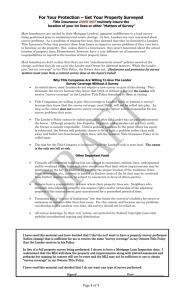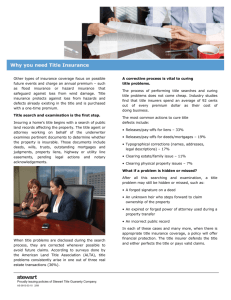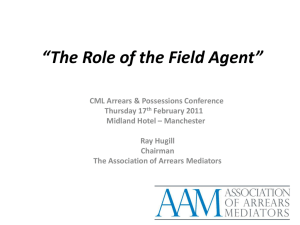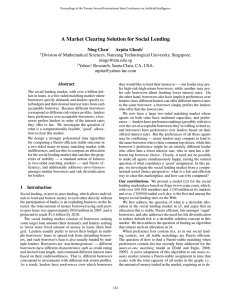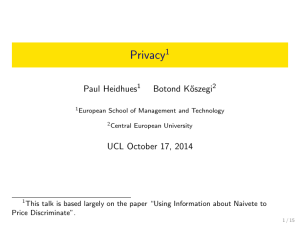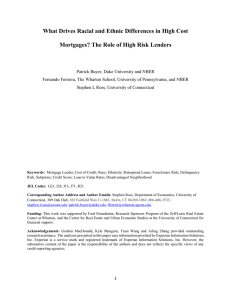Lectures 1-2: Introduction and rural credit markets
advertisement
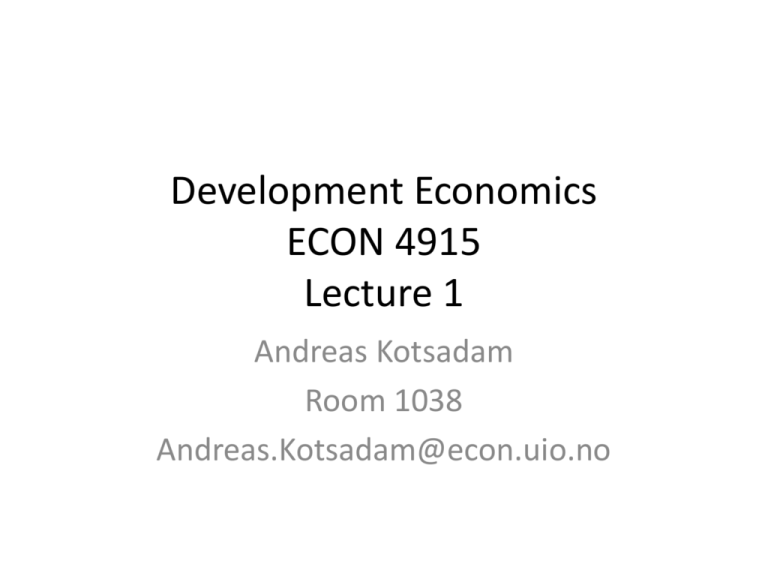
Development Economics ECON 4915 Lecture 1 Andreas Kotsadam Room 1038 Andreas.Kotsadam@econ.uio.no Why is this course important? • It concerns topics of high relevance... 9 million children below age 5 die every year. Malaria alone caused almost 1 million deaths in 2008. In SSA, one of every 30 women dies giving birth. 70% of the world population have 16% of world income. • ...that we should be able to solve. But very smart people disagree on the possible solutions. • Should the government give away mosquito nets for free? • How can we make more people go to school? • Why don’t farmers buy fertilizers, and should they? Is foreign aid good? • Jeffrey Sachs: YES Is foreign aid good? • William Eastery and Dambisa Moyo: NO Poverty traps • A fundamental difference between the camps is the view on poverty traps. • If a poverty trap exists, a big push (of for instance foreign aid) can move countries to a path leading to a better equilibrium. • Discuss the graphs in class. S-shape and inverted L • The role of multiple equilibria in the S curve. • Does the L curve imply that there is no problem? • What is the effect on permanent income of a big push in the S curve? • In the L curve? Do poverty traps exist? • Banarjee and Duflo: Depends on context The debate is ongoing • Two blogs that you should read regularly if you want to keep up with the latest papers and trends in development: • Chris Blattman: http://chrisblattman.com • Development impact: http://blogs.worldbank.org/impactevaluations This course • About half of the course consists of theory. • It is expected from you that you understand the models, that you can derive the most important results, and discuss the implications. Be critical! This course • The other half of the course consists of empirical papers. • It is expected from you that you understand how the results are obtained, that you can assess the identification strategy, and discuss the implications of the results. Be critical! Correlation is not causation • Are there some other variables that cause both less death and low income inequality? • What is causing what? • Are there outliers? Techniques to be discussed in class • Randomization. • Instrumental variables. • Panel data and difference in differences. • Regression discontinuity. Lecture plan • • • • • • • • • • • • • • • • • • • • • • • • Lectures 1-2: Introduction and rural credit markets (BU Ch. 7); Ray Ch. 14 Lecture3: Credit markets for the poor, what do we know? Burgess and Pande; Banarjee and Duflo Lecture 4: Insurance Ray Ch. 15 Lecture 5 Empirical methods in development economics (Cohen and Dupas); Duflo et al.(selected pages) Lecture 6: Migration Ray Ch. 10; Mishra Lecture 7: Gender and Development Duflo; Qian Lecture 8: Political and cultural change Beaman et al.; Jensen and Oster Lecture 9: Development and inequality Ray Ch 7; Fujiwara Lecture 10: Empirical evidence on the extent, causes, and effects of corruption Olken and Pande Lecture 11: Institutions and long run growth 1 Acemoglu et al; Gleaser et al Lecture 12: Long run effects of the slave trade Nunn and Wantchekon Lecture 13: Institutions and long run growth 2 Michalopoulos and Papaioannou Seminars • There will be six seminars during the course. • You will be divided into groups and the seminar questions will be posted on the homepage. • During the seminars, YOU (!) will present the answers to the questions. Rural credit markets • We shall seek to explain Why the poor often cannot borrow on the formal market. Why the poor pay so much interest on their loans, if they are able to borrow. The role of institutions. What can be done to improve the situation. Why is credit important? • Credit is needed for efficient production as well as smoothing out consumption. Production requires investments. Income streams often fluctuate. There are two basic (and related) problems • Moral hazard: Lenders cannot monitor the actions of the borrowers. • Adverse selection: Lenders cannot distinguish between borrowers with different characteristics. These problems are severe for formal lenders • They don´t have personal knowledge regarding the clients. • They cannot monitor how the loans are used. • Limited liability implies that borrowers take to much risk or default voluntarily. • Collaterals may solve this problem, but this is infeasible for the poorest. Informal lenders • Often have more information about the clients. • Are often able to monitor the clients. • Often accepts different types of collateral (including labor). Characteristics of rural credit markets • Information problems (also for informal lenders) leading to: • High interest rates. • Segmentation. • Interlinkage. • Interest rate variation. • Rationing. • Exclusivity. Lender’s risk hypothesis for informal lending Assume perfect competition. Let L= Loan amount, r= Lender’s opportunity cost, p= Fraction of loans repaid, and i= Interest rate. The expected profit of the lender is therefore: p(1 i)L (1 r )L Setting expected profits equal to zero (why?) and solving for the interest rate gives: 1 r i 1 p • What happens when there is no default risk? • How high is i if there is a 50-50 chance of default and the formal rate is 10 %? Main lesson of the model • Hence, even under competition informal sector interest rates are very sensitive to the default risk. • But is it true? True with an important twist • Looking at data it is obvious that defaults are quite rare in rural credit markets. • So, this mechanism of potential default is largely circumvented but this is costly. • This cost is basically what drives the observed high interest rates. • And since some of these costs are fixed, small loans demand a higher interest rate. Credit rationing • Why are people not allowed to borrow as much as they want at the going rate of interest? • This is also linked to the risk of default. • Let us show this in a simple model. Assume a large number of potential borrowers. Let L= Loan amount, i= Interest rate, A= opportunity cost of borrower f(L) = production function, f’(L)>0 f’’(L)<0 Farmers maximize profits: Max f (L) L(1 i) L s.t. f (L) L(1 i) A F.O.C : 0 L This gives: ?? Farmers maximize profits: Max f (L) L(1 i) L s.t. f (L) L(1 i) A F.O.C : 0 L This gives: f’(L)=1+i And the profits at this rate must exceed A. (a.k.a. ”Participation constraint”) The lender’s problem • The lender simply sets i=i* such that the farmers maximized surplus equals A. • Let us look at this graphically. • But note that so far there is no credit rationing: The farmer gets the desired loan given the interest rate. Let’s add risk of strategic default • Assume that the punishment for default is not being able to borrow again, and hence earn A for all remaining periods. • Let N>1 be the number of periods. • For default not to occur it must be that: Nf (L) L(1 i) f (L) ( N 1)A Rearranging gives N f ( L) L(1 i) A N 1 • This is the no-default constraint. • Since N>1, this constraint is tighter than the participation constraint. • You should be able to show that the F.O.C. For the farmer implies that: f’(L)=N/(N-1)(1+i) • See figure 14.3 in Ray for a graphical examination. This gives credit rationing • Why? • Because the MC of borrowing is still 1+i so the borrower would like to borrow more. • Why doesn’t the lender raise the interest to lend out more? Information assymetries and rationing • Information assymetries may also cause credit rationing as lenders are not able to fully observe if a borrower is of high or low risk. • Too high interest rates may drive away the low risk type of borrowers. • It may therefore be optimal to have a lower interest rate and a higher probability of recieving the money back. • Two types of borrowers: Type 1: safe type, earns R, R>L Type 2: risky type, earns R’ with probability p, R’>R, but zero otherwise. Assume that the lender only has a capital of L. What interest rate should the lender charge? Returns and participation constraints: • Expected return of type 1=R-(1+i)L • PC for type 1: i must be lower than or equal to R/L-1 • Expected return of type 2=p[R’-(1+i)L] • PC for type 2: i must be lower than or equal to R’/L-1 • Since R’>R, i2>i1 What interest rate should the lender set? • I2 gives expected profits of 2 p(1 i 2 )L L • i1 gives expected profits of 1 1 1 i1 L p(1 i1 )L L 2 2 The lender will charge i1 R if p then 1 2 2R 'R Now we know the theory behind: • Why interest rates are high. • Why there is credit rationing. • It all has to do with information asymmetries in the following way: Adverse selection and moral hazard • Adverse selection: If banks raise interest rates the project mix will become riskier. • Moral hazard: If interest rates increase, borrowers themselves choose more risky projects and/or put in less effort to repay.


